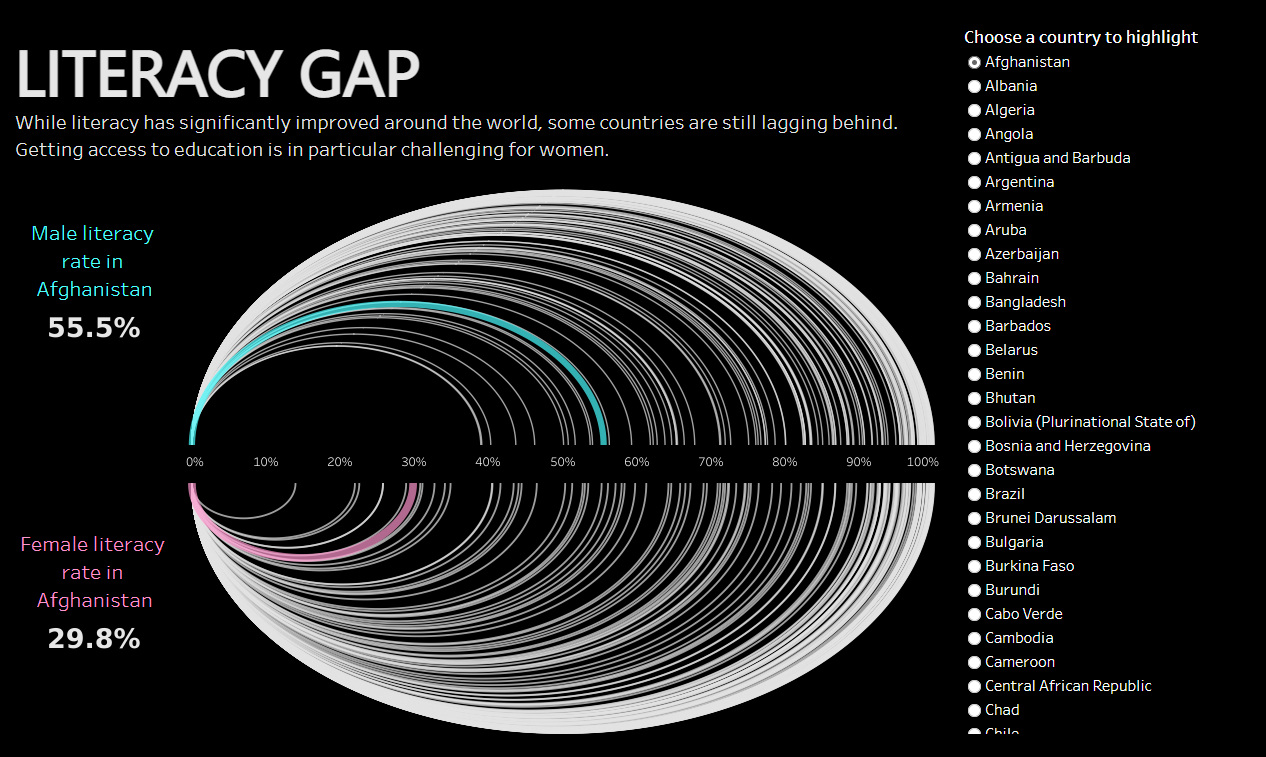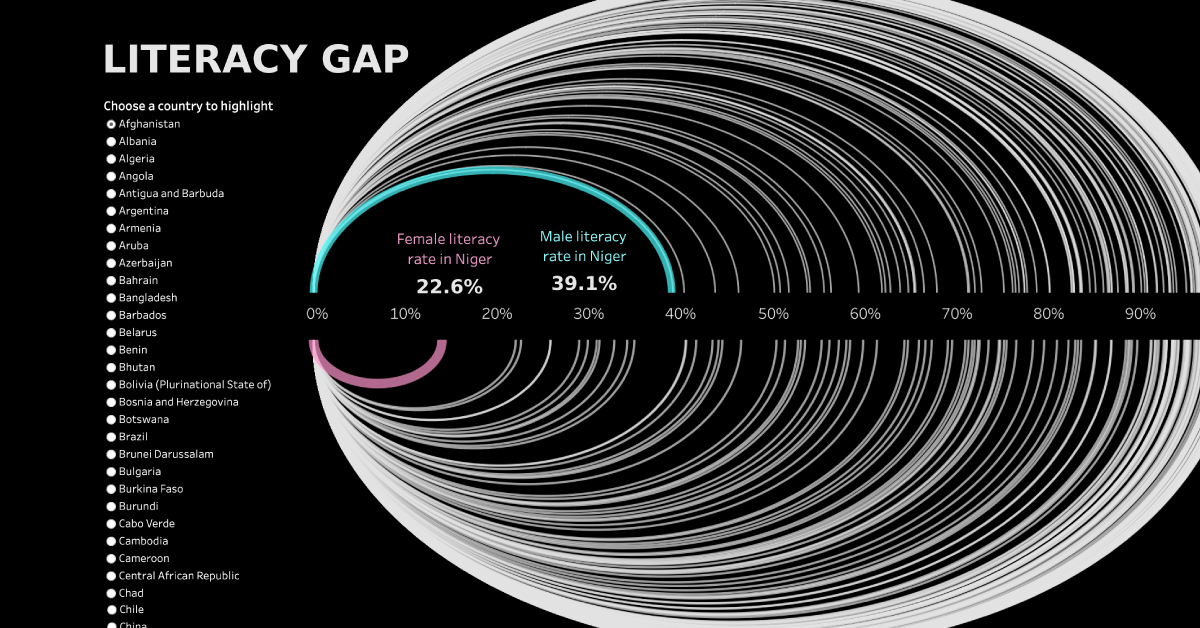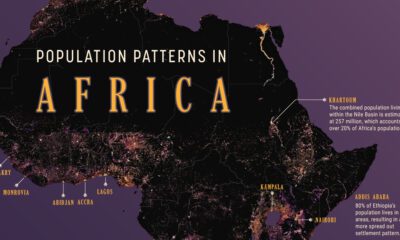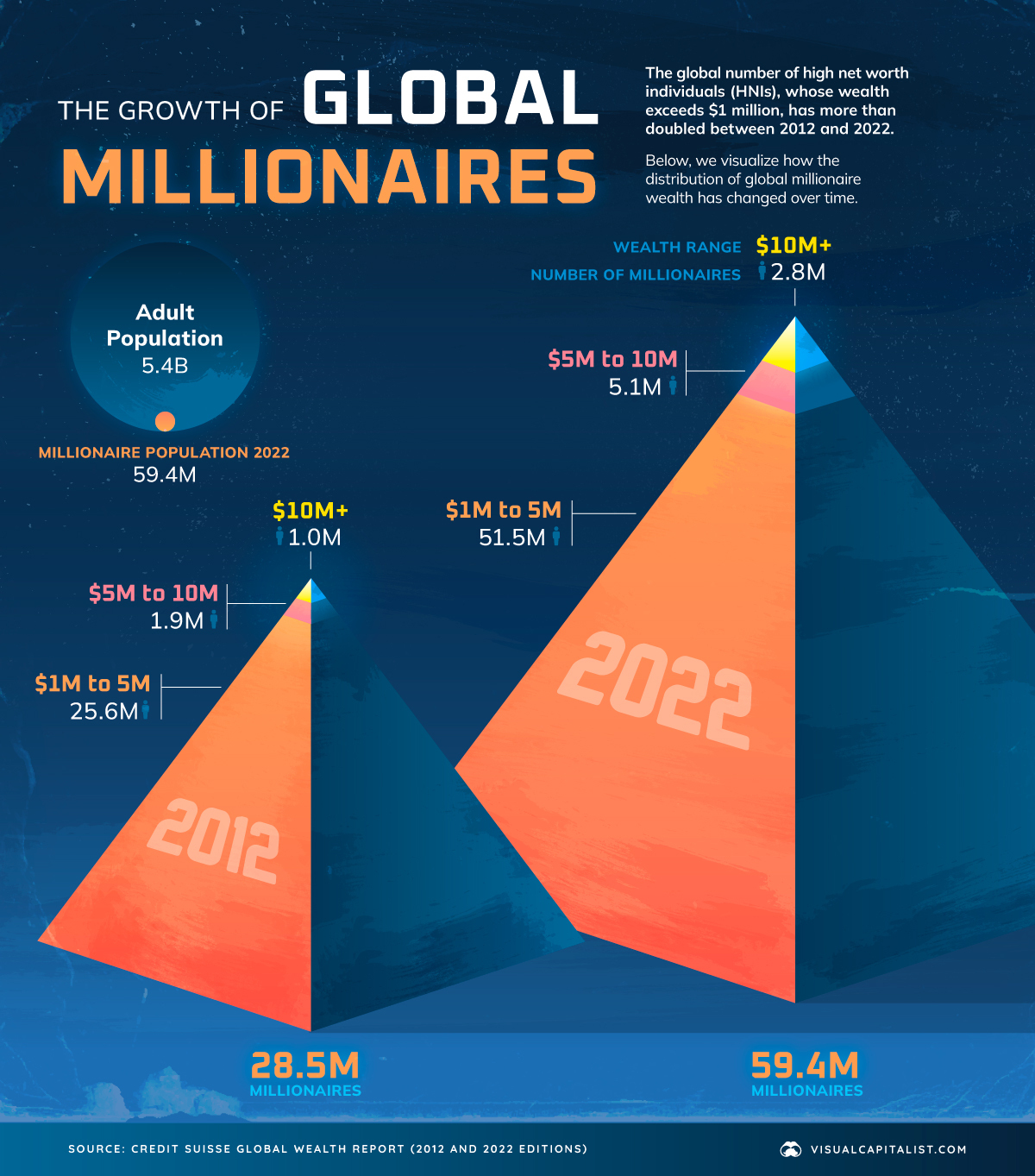Inequality
Visualizing Literacy Rates Around the World
var divElement = document.getElementById(‘viz1645471158099’); var vizElement = divElement.getElementsByTagName(‘object’)[0]; vizElement.style.width=’1366px’;vizElement.style.height=’795px’; var scriptElement = document.createElement(‘script’); scriptElement.src = ‘https://public.tableau.com/javascripts/api/viz_v1.js’; vizElement.parentNode.insertBefore(scriptElement, vizElement);
Open the large interactive version here
Visualizing Literacy Rates Around the World
For many people around the world, the ability to read is an essential tool that’s needed for day-to-day life. Yet, despite its importance, approximately 773 million people across the globe do not have access to this basic, often life-saving skill. When it comes to literacy rates, which countries are leading the way, and which ones are lagging behind?
This graphic by Eleonora Nazander visualizes literacy rates in over 150+ countries and provides a breakdown of male versus female literacy rates in each country, using data from UNESCO.
Countries with The Highest Literacy Rates
From 1960 to 2015, global literacy has grown from 42% to 86%—an approximate 4% increase every five years.
While overall literacy rates have increased, some countries have seen more growth than others. Out of the countries included in the dataset, here’s a look at the countries with the highest literacy rates, according to the latest available figures:
| Country | Female Literacy Rate | Male Literacy Rate |
|---|---|---|
| 🇺🇦 Ukraine | 100.0% | 100.0% |
| 🇺🇿 Uzbekistan | 100.0% | 100.0% |
| 🇪🇪 Estonia | 99.9% | 99.9% |
| 🇱🇻 Latvia | 99.9% | 99.9% |
| 🇸🇲 San Marino | 99.9% | 99.9% |
| 🇨🇺 Cuba | 99.8% | 99.7% |
| 🇱🇹 Lithuania | 99.8% | 99.8% |
| 🇷🇺 Russia | 99.7% | 99.7% |
| 🇦🇲 Armenia | 99.7% | 99.8% |
| 🇧🇾 Belarus | 99.7% | 99.8% |
| 🇰🇿 Kazakhstan | 99.7% | 99.8% |
| 🇹🇯 Tajikistan | 99.7% | 99.8% |
| 🇦🇿 Azerbaijan | 99.7% | 99.9% |
| 🇧🇧 Barbados | 99.6% | 99.6% |
| 🇸🇮 Slovenia | 99.6% | 99.7% |
| 🇹🇲 Turkmenistan | 99.6% | 99.8% |
| 🇹🇴 Tonga | 99.5% | 99.4% |
| 🇵🇼 Palau | 99.5% | 99.5% |
| 🇬🇪 Georgia | 99.5% | 99.7% |
| 🇰🇬 Kyrgyzstan | 99.5% | 99.7% |
All countries on this list have nationwide literacy rates above 99%, with Ukraine and Uzbekistan both clocking in at 100%.
One country on this list that’s worth touching on is Cuba. The country’s high literacy rate of 99.8% is arguably the result of a campaign that dictator Fidel Castro launched in 1961, which aimed to abolish illiteracy in the country. In less than a year, more than 700,000 Cubans learned basic literary skills.
While Castro’s government imposed rigid censorship and is labeled by critics as an oppressive regime, this literacy campaign also likely influenced surrounding Latin American countries, leading to improved literacy rates in the region.
Countries with the Lowest Literacy Rates
On the other end of the spectrum, here’s a look at the countries on the list with the lowest literacy rates. As the data shows, a staggering amount of the world’s illiterate population is in Sub-Saharan Africa:
| Country | Female Literacy Rate | Male Literacy Rate |
|---|---|---|
| 🇹🇩 Chad | 14.0% | 38.9% |
| 🇳🇪 Niger | 22.6% | 39.1% |
| 🇸🇸 South Sudan | 28.9% | 40.3% |
| 🇬🇳 Guinea | 22.0% | 43.6% |
| 🇲🇱 Mali | 25.7% | 46.2% |
| 🇧🇫 Burkina Faso | 32.7% | 50.1% |
| 🇨🇫 Central African Republic | 25.8% | 50.7% |
| 🇸🇱 Sierra Leone | 34.9% | 51.6% |
| 🇨🇮 Côte d'Ivoire | 40.5% | 53.7% |
| 🇧🇯 Benin | 31.1% | 54.0% |
| 🇦🇫 Afghanistan | 29.8% | 55.5% |
| 🇮🇶 Iraq | 44.0% | 56.2% |
| 🇪🇹 Ethiopia | 44.4% | 59.2% |
| 🇬🇲 Gambia | 41.6% | 61.8% |
| 🇬🇼 Guinea-Bissau | 30.8% | 62.2% |
| 🇱🇷 Liberia | 34.1% | 62.7% |
| 🇲🇷 Mauritania | 43.4% | 63.7% |
| 🇰🇲 Comoros | 53.0% | 64.6% |
| 🇵🇬 Papua New Guinea | 57.9% | 65.3% |
| 🇭🇹 Haiti | 58.3% | 65.3% |
The country with the lowest literacy rate covered in this data is Chad, coming in at just 14.0% for female literacy and 38.9% for male literacy. This is due to a number of factors, one being poor access to education. In 2019, more than 700,000 children weren’t in school, and almost 500,000 of them were female.
However, it is worth noting that Chad’s youth population is much more literate than its senior population—over 30% of youth (aged 15-24) are literate, compared to just 7% of seniors (aged 65+) which shows how education has improved over the years—even if there’s still a long way to go.
Gender Disparities in Global Literacy
A broad target in the official list of the UN’s Sustainable Development Goal 4 is to close the gender gap in education. And as the data shows, some regions are already meeting this target, with most countries in Central Asia, Europe, Northern America, Eastern and South-Eastern Asia, and Latin America already at virtual gender parity for literacy.
That being said, countries in Northern Africa, Sub-Saharan Africa, Western Asia, and Southern Asia are still showing significant disparities between genders. Here’s a look at the countries with the largest gender gaps in literacy:
| Country | Male literacy | Female literacy | Gender Gap (p.p.) |
|---|---|---|---|
| 🇬🇼 Guinea-Bissau | 62.2% | 30.8% | 31.4% |
| 🇱🇷 Liberia | 62.7% | 34.1% | 28.6% |
| 🇦🇴 Angola | 80.0% | 53.4% | 26.6% |
| 🇹🇬 Togo | 77.3% | 51.2% | 26.1% |
| 🇸🇳 Senegal | 66.3% | 40.4% | 25.9% |
| 🇦🇫 Afghanistan | 55.5% | 29.8% | 25.7% |
| 🇨🇫 Central African Republic | 50.7% | 25.8% | 24.9% |
| 🇹🇩 Chad | 38.9% | 14.0% | 24.9% |
| 🇵🇰 Pakistan | 71.1% | 46.5% | 24.6% |
| 🇧🇯 Benin | 54.0% | 31.1% | 22.9% |
Guinea-Bissau in West Africa has the greatest gender literacy gap, with a literacy rate for males that is 31.4 percentage points higher than females. One possible reason for the gap is the high instances of child marriage in the country—approximately 37% of women are married before they’re 18.
While various organizations have created programs to help girls in Guinea-Bissau stay in school, a gap of this size will likely take considerable time and effort to close.

This article was published as a part of Visual Capitalist's Creator Program, which features data-driven visuals from some of our favorite Creators around the world.
Money
Visualizing the World’s Growing Millionaire Population (2012-2022)
The world’s millionaire population has more than doubled in the last decade between 2012 and 2022. We visualize these numbers here.
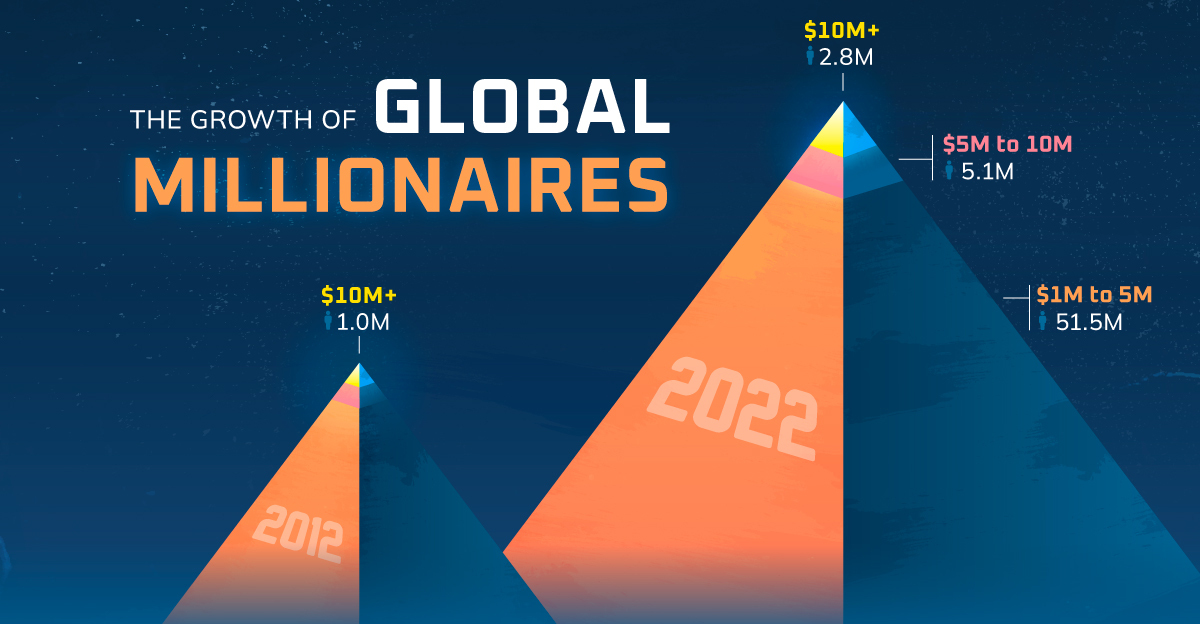
Visualizing the World’s Growing Millionaire Population
Reaping the rewards of tech revolutions, market booms, and more, the last decade has seen a remarkable increase in the global number of millionaires.
In 2022, 1.1% of all of the world’s adults were millionaires, up from 0.6% in 2012.
In today’s visualization, we dive into the world’s growing millionaire population using data from this year’s Global Wealth Report by Credit Suisse.
The Global Millionaire Population, Then and Now
In 2022, total millionaire wealth stood at $208.3 trillion, accounting for 45.8% of global wealth. That represents a 138% increase from 2011, when millionaires held $87.5 trillion in wealth.
While the rise can be attributed to a number of factors, financial assets have accounted for most of the increase in total wealth since the 2008 Financial Crisis, according to Credit Suisse.
Here’s a look at the explosive growth in the number of millionaires from 2012 to 2022:
| Wealth range | Number of adults (2012) | Number of adults (2022) |
|---|---|---|
| $1-5M | 25.6 million | 51.5 million |
| $5-10M | 1.9 million | 5.1 million |
| >$10M | 1.0 million | 2.8 million |
At the very apex of these pyramids, the number of ultra-high-net-worth individuals (all holding $50 million or more in wealth) has nearly tripled over the last decade.
Where are the world’s millionaires mostly found?
- 42%: North America
- 27%: Europe
- 16%: Asia-Pacific (ex. China and India)
- 10%: China
- 5%: Rest of the World
In total, the world’s millionaire population amounted to 59.4 million adults in 2022.
Despite inflation, interest rates, and current market conditions hampering wealth creation for many in 2022 and 2023, Credit Suisse forecasts that the number of millionaires will still grow to 86 million by 2027, a 45% increase from 2022.
The Outlook for Wealth Inequality
Although wealth inequality fell slightly in 2022, a significant chunk of overall global wealth still belongs to the wealthiest parts of the population.
In stark contrast to millionaires, 52.5% of the world’s adults had less than $10,000 in wealth, and combined for just 1.2% of global wealth.
From a big picture perspective, however, worldwide wealth inequality has trended downward over the last two decades. That is, before the 2020–2021 period when the wealth gap was exacerbated due to the pandemic and the subsequent boom in share and house prices.
Looking ahead to 2027, Credit Suisse forecasts that the share of adults with less than $10,000 in wealth will fall, with more adults moving into the middle and upper income levels. It’ll be interesting to see if global wealth inequality continues its long-term downward trajectory.
Where does this data come from?
Source: Credit Suisse Global Wealth Report (2022 and 2012 versions)
-

 Real Estate2 weeks ago
Real Estate2 weeks agoVisualizing America’s Shortage of Affordable Homes
-

 Technology1 week ago
Technology1 week agoRanked: Semiconductor Companies by Industry Revenue Share
-

 Money1 week ago
Money1 week agoWhich States Have the Highest Minimum Wage in America?
-

 Real Estate1 week ago
Real Estate1 week agoRanked: The Most Valuable Housing Markets in America
-

 Business2 weeks ago
Business2 weeks agoCharted: Big Four Market Share by S&P 500 Audits
-

 AI2 weeks ago
AI2 weeks agoThe Stock Performance of U.S. Chipmakers So Far in 2024
-

 Misc2 weeks ago
Misc2 weeks agoAlmost Every EV Stock is Down After Q1 2024
-

 Money2 weeks ago
Money2 weeks agoWhere Does One U.S. Tax Dollar Go?

